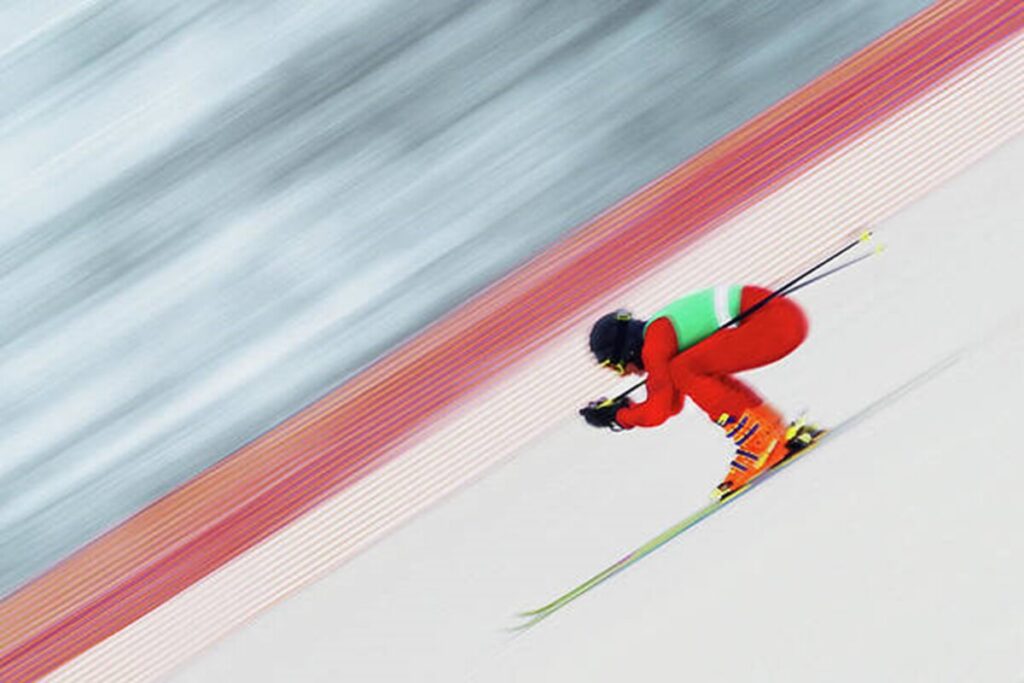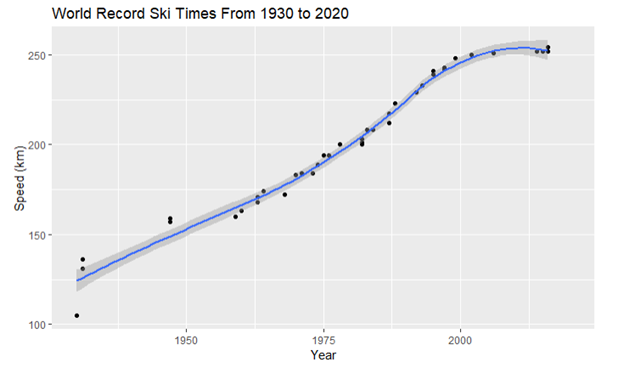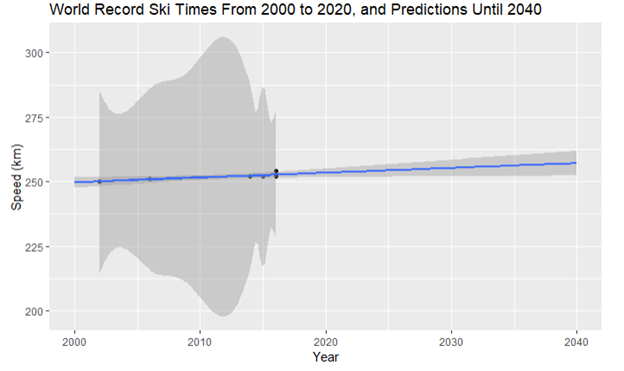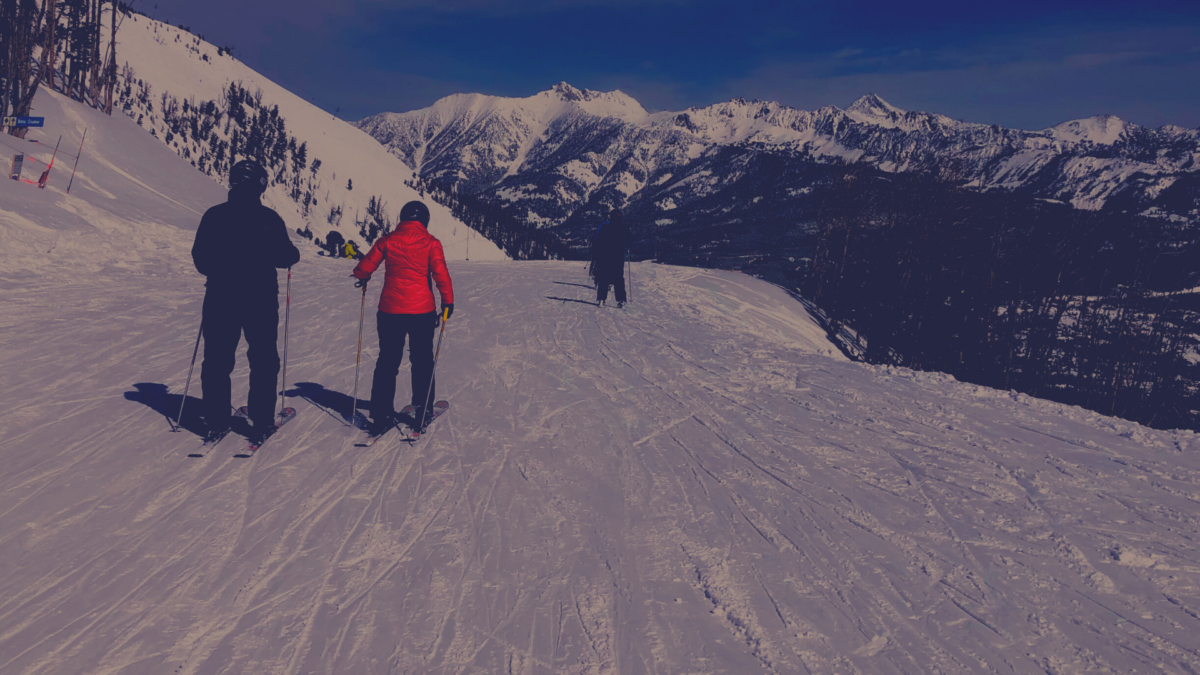
Exploring speed is human nature. No matter the task, activity, or operation, curiosity inevitably peaks one’s mind to wonder how fast it can be done. The sport of skiing is no outlier. For as long as skiing has existed, it is thought that people have tested their abilities to ski as fast as they can. Eventually, this culminated into an extreme sport called speed skiing. Through time and competition, speed skiing gained popularity and legitimacy. Today, the sport is recognized by the International Ski Federation and is raced worldwide.
Speed skiing has come a long way since its beginnings. In fact, the world record has nearly doubled in speed during the last century of racing. Much of this can be attributed to the athletes for their daring attitude during races, and much can be attributed to the exponential advancement of technology over that time frame. Today, we cover the second part: technology and speed skiing. Specifically, how technology has paved the way for the blistering speed we take for granted today in the sport.
This blog has three parts. First we will cover the history of speed skiing, and major events in the sport. Then we will take a look at the data, and extrapolate what the future holds for speed skiing. Finally, we will analyze the technological changes that lead to records being shattered.
Part 1: What is Speed Skiing and its History?
Speed skiing, appropriately named, is the sport where skiers compete for speed down a slope. The rules of the sport are simple, each skier takes turns flying down a steeply slanted course for a kilometer. Towards the middle of the slope, there is a 100 meter “timing zone” where the exact speed of the racers is monitored. The skiers then use about half the course to slow down from their blistering speeds before reaching the crowd at the bottom. The racer that is able to produce the fastest time within the timing zone is the winner. There are around 30 speed skiing courses worldwide, each following the strict guidelines set out by the sport. Although speed skiing is popular among fans, it has not been made an official Olympic sport, largely due to its dangerous nature.
Speed skiing started becoming popular in the 1930s, which meant that the speed skiing world record started becoming a lofty goal for many prominent skiers. Although the record for speed skiing started being traced in the late 19th century when Tommy Todd reportedly topped out at a speed of 140 km/hr, it wasn’t until the 1930s when speed skiing records starting becoming “official.” In 1930, a skier by the name of Gustav Lantschner was able to record the first official record with a top speed of 105km/hr. This record was short-lived however with Leo Garsperl recording a speed of 136km/hr just a year later. After Garsperl’s run, it would take many years before someone could top his speed. The records seemed to plateau for three whole decades. Then, in the 1960s, huge change cratered through the sport. Records seemed to fall on a yearly basis with each top speed dominating the old record. It is no surprise that this is also the time period when technological advances surged within the sport. The highlights of these advances include ski poles that bend around the body when in a tucked position, non-porous suits, and flat top skis. This period of rapid advancement lasted about four decades until the early 2000s. The current world record is help by Ivan Origone, with a speed of 254 km/hr.
Part 2: What the Data Tells Us
My goal when I started this project was to try to predict how the world record speed skiing time will continue to increase into the future. Being a quantitative sciences major, I knew that I might be able to create a model that does just that using data. With some quick searching online, I was able to find exactly the type of data I wanted to use to create such an analysis. The data was made up of each world record-breaking speed over time, and I was able to easily export the data into an Excel sheet. From there, I imported the data into RStudio for my preferred method of analysis. For those unfamiliar with data analysis, RStudio is a useful tool where you can write code in the R coding language to analyze and visualize data. RStudio offers a pleasant way of running any analysis, and I highly recommend utilizing it if you find yourself in the middle of a data analysis project.
After importing the data into RStudio, I decided to play around with the data to become more familiar with it. Here are some quick facts I learned from the data before we start modeling. The world speed skiing record has been broken 41 times since 1930 by 29 individuals. Worldwide the record has been broken at 7 distinct courses, with the most common place to break the record in Cervinia, Italy (13 times the record has been broken there). Since 1930, the record has improved 242%! And since 1960, the record has grown 156%. From this simple analysis, it is abundantly clear how much this global sport has grown in recent history.

Now, after familiarizing myself with the dataset, I wanted to fit a model to the data to try to find a time series trend for how fast the record is improving over the years. Using the predict module built into R software, I was able to fit a line of best fit into the data. However, this line was linear. This is a problem, as the trend of world records clearly wasn’t linear. We can know this simply by looking at the plot of world records. From 1930 to around 2000, the records appear to increase at a somewhat constant rate. However, after 2000, the trend begins to change to a much slower rate. Therefore, to predict future world records, I only used data from the last 20 years. Any trend before 2000 does not give a good estimate of how trends have progressed since then, so it does not make sense to use data from that period to predict future times.

Using the data from the last 20 years and the predict function built into R, I was able to create a line of best fit. Using this line, I can extrapolate how the trend will continue. For the sake of this analysis, I model the expected world record up until 2040, as the accuracy of this model will decrease the longer I extrapolate out to. The results are shown below. The blue line represents the best guess of the record over time, with the shaded gray area representing uncertainty. According to the model, there is a 95% chance that the actual record will fall into the shaded gray area in any given year. As you can see from the graph, the rate of change for the record will likely remain small. It is not expected that the world record will break into the 260 km/hr range until the early 2030s. I should note that because of the small sample size of data we are dealing with, it is possible that the model has intrinsic bias, meaning it may be inaccurate. Only time will tell.
Part 3: How Technology Changed the Sport
If you were to watch a speed skiing event today for the first time, you might be shocked by how otherworldly the skiers look. The first thing that would catch your attention is the ski suit. These suits, made of polyurethane coated polypropylene, are shiny, bold, and sleek. Most often, the suits come in a rich red color that contrasts the snow. The next thing you might notice are the helmets. Speed skiers wear helmets that are designed to be as aerodynamic as possible. In the context of skiing, that means the helmets cover the entire face and curve backwards. If you saw one of these helmets outside of a skiing event, you might even think it was an invention from NASA. If you look more closely, you’d also notice some minor features that aren’t common to ordinary skiing. For one, the ski poles they use bend to the shape of their body. This is done to make the body even more aerodynamic when in racing position. All of these inventions were made to give speed skiers an edge on each other. You can think of speed skiers in an arms race against each other, where the weapon is technology. Even the most marginal of changes to make oneself more aerodynamic could make the difference between winning and losing in this sport. The majority of the innovation within the sport began spawning in the 1960s, with new technology introducing itself until the late 1990s. It isn’t a coincidence that this is the same period where the world record saw most of its growth. Now, in the 2000’s, innovation seems to have stalled. Some recent methods of increasing speed include a starting ramp for the skiers made from turf. However, this had only slight affects on the skier’s speed. Some modern skiers even take to smoothing out the bumps on their kneecaps for their runs to become more aerodynamic. And of course, each competitor will thoroughly wax their skis before their turn. It is almost impossible to think of something new that the skiers haven’t already tried to become faster.
Technology is also in a balancing act with safety as well. As expected when clocking speeds upwards of 200 km/hr, speed skiing is an inherently dangerous sport. Much of the reason why speed skiing is not in the Olympics is because of its risks. The International Olympic Committee (IOC) tries to limit the danger in its recognized sports for the viewers. With many having died in speed skiing crashes, it was not too hard of a decision for the IOC to block it from their competitions.
Conclusions
The world record of speed skiing, while niche, is extraordinarily competitive. Although much of the growth we have seen in the sport is due to technological changes stemming from the 1960s, we still occasionally see some growth in modern times (even small growth counts). Because technology has hit a theoretical wall in speed skiing, we don’t expect to see the same kind of record-shattering performances the sport became accustomed to for a few decades. According to my model, the world record might not increase more than 10 km/hr in the next two decades. But who knows, another rampage of technology could be around the corner for us to discover. My guess is that the next advances will be in safety for the sport, as that is the main reason why it’s still, not an Olympic sport. Maybe in the future, we will see speed skiing records on the Olympic stage in a safe environment.
Bibliography:
Andersen, Ross E., and David L. Montgomery. “Physiology of Alpine Skiing.” Sports Medicine. November 25, 2012. Accessed May 07, 2021. https://link.springer.com/article/10.2165/00007256-198806040-00003.
Angus, Simon D. “A Statistical Timetable for the Sub–2-Hour Marathon.” Medicine & Science in Sports & Exercise 51, no. 7 (2019): 1460-466. doi:10.1249/mss.0000000000001928.
Dorworth, Dorworth, Brent On December 9, Pessey Georges on March 30, and Doug Daggs on March 10. “A Speed Skiing History.” Dick Dorworth. December 05, 2015. Accessed May 07, 2021. http://www.dickdorworth.com/2015/12/05/a-speed-skiing-history/.
Dorworth, Dick. The Straight Course: Speed Skiing in the Sixties. Sedona, AZ: Western Eye Press, 2011.
Krichko, Kade. “How the Niche World of Speed Skiing Is Quietly Getting Even Faster.” POWDER Magazine. December 19, 2017. Accessed May 07, 2021. https://www.powder.com/stories/features/how-the-niche-world-of-speed-skiing-is-getting-even-faster/.
Peters, Justin. “Speed Skiing Is the Fastest Non-Motorized Sport on Earth. Why Isn’t It in the Olympics?” Slate Magazine. February 09, 2014. Accessed May 07, 2021. https://slate.com/culture/2014/02/speed-skiing-why-isnt-it-an-olympic-sport.html.
Shealy, Je, Cf Ettlinger, and Rj Johnson. “How Fast Do Winter Sports Participants Travel on Alpine Slopes?” Skiing Trauma and Safety: Fifteenth Volume. doi:10.1520/stp12212s.
“Skiing History Magazine (Formerly Skiing Heritage) Back …” Accessed May 7, 2021. https://skiinghistory.org/resources/skiing-history-magazine-formerly-skiing-heritage-back-issues.
“Speed Ski History.” Simone Origone. Accessed May 07, 2021. http://www.simoneorigone.com/en/kl-speed_ski-history/.
TGodbout. “How Fast Can We Really Ski?” Elite Skiing. October 10, 2017. Accessed May 07, 2021. https://eliteskiing.com/2017/10/10/how-fast-can-we-really-ski/.
Usborne, Simon. “Speed Skiing: Too Fast for the Olympics.” Financial Times. February 09, 2018. Accessed May 07, 2021. https://www.ft.com/content/f4c4251e-0816-11e8-9e12-af73e8db3c71.
“Using R for Time Series Analysis.” Using R for Time Series Analysis – Time Series 0.2 Documentation. Accessed May 07, 2021. https://a-little-book-of-r-for-time-series.readthedocs.io/en/latest/src/timeseries.html.
“What Is It Speed Skiing. Encyclopedia.” En.google. Accessed May 07, 2021. https://amp.en.google-info.in/322186/1/speed-skiing.html.
